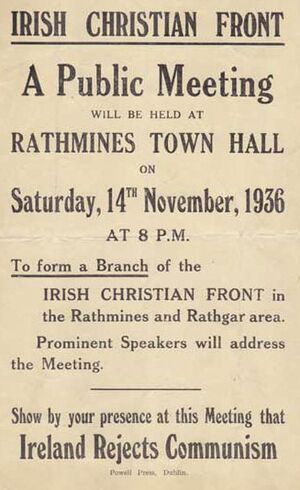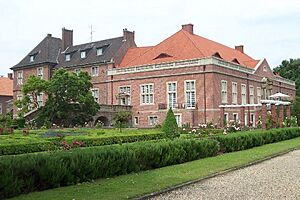Aileen O'Brien facts for kids
Aileen von Vittinghof gennant Schell zu Schellenburg (born O'Brien; January 4, 1913 - October 30, 2000) was an American writer, journalist, and political activist. She was a strong Catholic and was against communism. She is known for her 1938 lecture tour in the United States. During this tour, she spoke in favor of the Nationalist side in the Spanish Civil War.
Contents
Early Life and Education
Aileen O’Brien was born on January 4, 1913, in San Francisco. Her parents were William and Margaret O’Brien. Soon after her birth, her family moved to Bolivia. She spent much of her childhood in Bolivia and Chile. In 1927, she went to Switzerland to continue her education. She later graduated from the University of Freiburg. While in Switzerland, she helped start a journal called The Colosseum. She also became a secretary for Pro Deo, which was a Christian group against communism.
Activism in Ireland and Spain

In 1934, O’Brien moved to Ireland with her family. She continued her work with Pro Deo as an organizing secretary for Ireland and England. In 1936, she helped create the Irish Christian Front (ICF). This group was formed to support and raise money for the Nationalist side in the Spanish Civil War. However, it quickly became a political group that opposed the Irish government.
Aileen was the organizing secretary for the ICF. Later, she became its representative in Spain. She believed that communism was a threat to Ireland. She said that communism wanted to get rid of national identity and make Ireland just a part of the Communist International. She warned that communists would promise people what they wanted to gain control.
In Spain, O’Brien helped manage the money raised by the ICF. She worked with Cardinal Goma to make sure the funds were used correctly. She also helped organize medical and other aid for the Nationalists. She was involved with Auxilio Social, a group that helped widows, orphans, and poor people by giving them food and clothes. She also worked closely with the Irish Brigade. This group of about 700 Irishmen fought for the Nationalists.
Speaking Tour in the United States
In early 1938, after 17 months in Spain, O’Brien traveled to the United States. She went on a lecture tour to speak for the Spanish Nationalists. Besides her lectures, she met with many important people, including members of the US Congress.
Her speeches often drew large crowds. Sometimes, there were also protests. In Oakland, protestors clashed with police outside one of her lectures. This event led to injuries and arrests. Aileen’s speeches stressed that General Franco and the Nationalists were not fascists. She said they were fighting for Christianity and against communism and anarchism. She also highlighted the Nationalists’ achievements in areas like workers’ rights, gender equality, education, and housing. She compared the actions of the Republicans with the Nationalists’ supposed respect for the rules of war.
Luis Bolín, a Nationalist writer, said that while in the US, O’Brien called every Catholic bishop in the country. She asked them to tell their priests to have their church members send telegrams to President Roosevelt. Bolín claimed that over a million telegrams were sent to the White House. As a result, a shipment of weapons to the Republicans was stopped.
Later Life and Legacy
After the Spanish Civil War, O’Brien continued to live in Spain. She also worked for the Spanish government. In 1940, she wrote a book called The Besieged of the Alcazar. It was about a Catholic soldier fighting in the Siege of the Alcázar. She was also a writer for the 1943 comedy film Castillo de naipes.
In 1950, she married a politician and baron named Felix von Vittinghoff-Schell in Madrid. The couple later moved to Castle Kalbeck in Weeze, Germany. This castle was the baron's family home. Aileen O’Brien died in Germany in 2000 at the age of 87.


